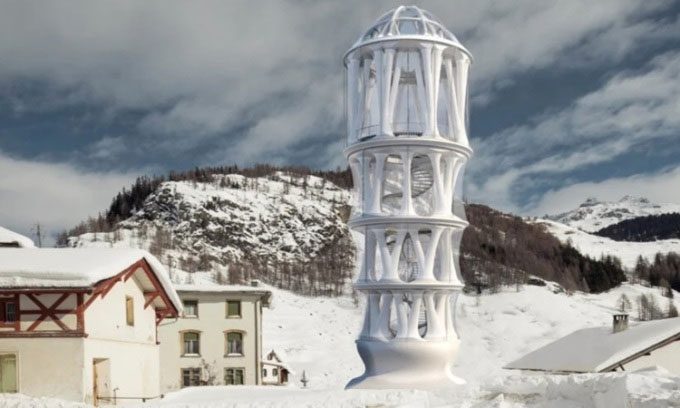The 30-meter White Tower will be constructed along the Julier Pass in the Alps using precast columns created through 3D printing.
Construction of the 30-meter White Tower in the remote village of Mulegns in the Swiss Alps will commence on February 1, 2024, with the introduction of 3D-printed columns. The first eight columns of the lower level will be printed by robots at the Swiss Federal Institute of Technology (ETH Zurich), forming part of a series of hollow twisted columns that incorporate the White Tower’s joints. This 3D printing project does not require a framework; instead, steel reinforcements are added during the automated manufacturing process. The White Tower is designed to be modular, allowing it to be relocated after five years in Mulegns, according to Design Boom.

Design of the White Tower located in the Alps. (Image: Design Boom).
The White Tower is a design by architects Benjamin Dillenburger and Michael Hansmeyer for the organization Fundaziun Origen. The digital construction technology company at ETH Zurich developed the tower construction technology in collaboration with the Institute for Structural Analysis and Design (CSBD) and the Institute for Construction Materials (PCBM). According to the timeline provided by Michael Hansmeyer, the columns of the White Tower will be assembled in May, with an expected opening in June 2024.
The tower consists of 32 branching columns surrounding airy rooms in an abstract style, guiding visitors to a concert hall at the tower’s peak. The concert hall can accommodate 45 people and offers panoramic views of the Julier Valley. In terms of sustainability, the construction company employs an automated concrete casting process that significantly reduces material consumption.
The White Tower is an innovative architectural project built directly above a historical railway carriage repair shop in the village of Mulegns. The structure is designed as a six-story building, creating a series of spaces known as vertical linear rooms. According to the company, these spaces vary greatly in terms of ventilation and light, transitioning from closed and dark rooms below to bright and airy rooms at the top of the tower.
Each tower level features distinctive decorative systems that contribute to a unique spatial experience for visitors. However, all levels are unified through the use of materials. Additionally, the White Tower will be protected from harsh weather conditions, such as snowstorms in winter, by a removable membrane layer. This protective measure helps ensure the longevity and integrity of the structure.
The architects utilized computer-aided design software to create the White Tower and transform it into a digital model. Using a large robotic arm, thin layers of specially formulated concrete are extruded according to the digital design to build the structure. Steel reinforcements can be integrated during the printing process to enhance structural durability.
After printing, final finishing touches such as smoothing or decorative details are applied. The printed components are then assembled on-site using modular construction techniques. Throughout the process, engineers pay close attention to precision and quality control to ensure safety and achieve the desired design effectiveness.




















































